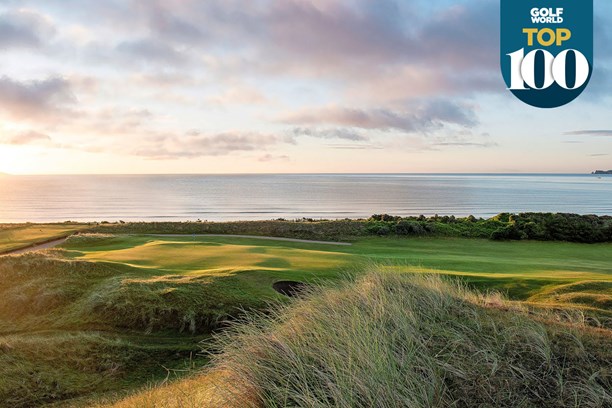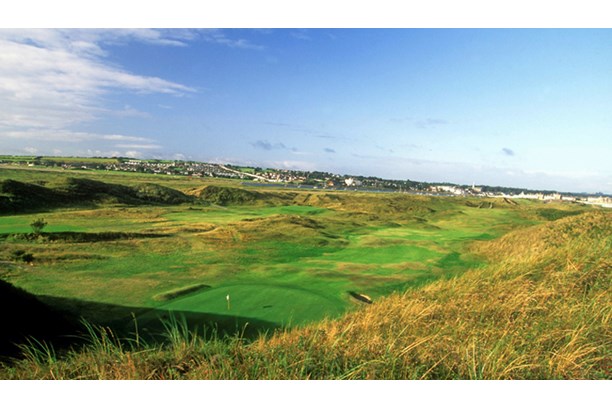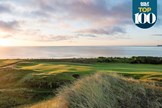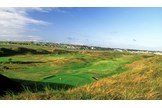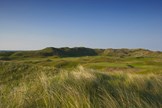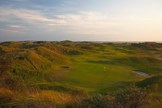The Island Golf Club
Last updated:
What we say
The Island Golf Club is no longer on an island, and has changed a lot since the 1880s, but it remains one of the best links golf courses in Ireland.
When you stand on the 14th tee at The Island, there are two things you need to know: you are standing where the original clubhouse stood for decades; and you are about to tackle the narrowest fairway in Ireland, possibly the world.
The Island enjoys a certain mystique, which is no surprise given its name and its history. The name itself conjures up images of misty morning boat crossings and golfers peering through the gloom, aching for that first glimpse of fairway, flag and dune.
Less than 15 miles miles north of Dublin’s city centre, the course is not actually on an island. It is reached by road. But that simplifies a rich history that did indeed see golfers crossing the estuary in boats.
COURSE REVIEW: Malahide Golf Club
The course is laid out on a peninsula of heaving dunes, caught between sea and salt marshlands. Travelling by boat was the only way to reach this spit of land until a road was built in 1973. It changed everything and 80 years of boat crossings came to an end, the walkway over the water fell into disuse and both the clubhouse and 1st tee moved to the opposite end of the peninsula. And that is where they remain today. Such beginnings, however, remain an essential piece of The Island’s folklore.
The history of the club dates back to the 1880s, when four golfers set forth to find land where they might play Sunday golf. Their home club, Royal Dublin, forbade golf on the holy day but the avid golfers had other plans. What they found was a wild peninsula, known locally as ‘The Island’, with the Irish Sea and the Malahide Estuary surrounding it in an embrace of almost 360 degrees. They promptly established a golf club and formed a syndicate to run it. Members who were invited to join could only do so for a year at a time. Not only was The Island one of Ireland’s first golf clubs, it was also one of the most exclusive.
That exclusivity remained until 1952, when the club was handed over to the annual ticket holders. This was a turning point, promising greater access to those wishing to play the course, as well as the opportunity for the course to develop.
The names of the course’s original designers have long been lost, but it is the names of Fred Hawtree and Eddie Hackett who are most closely associated with the golf course played today. They were brought in during the 1970s, and their work directly led to the reputation the club now enjoys. Out went some of the more severe blind shots, helping to make the course more playable; in came new holes, such as the straight par four 1st, cast between the dunes, and the looping par five 10th, which curls around out of bounds on the course’s western boundary.
Courses everywhere have been lengthened in recent years to meet the demands of the modern game and The Island is no different. Further redevelopment work took place in the 2000s, this time under the guidance of Fred Hawtree’s son, Martin. But only so much can be achieved on a peninsula and so the original character is very much intact. It means that many holes remain true to their roots, building on the course’s legacy, showing the vision of those early designers and emphasising how a brilliant hole of yesteryear can be regarded in exactly the same way today. Of those that are unchanged, the 13th and 14th are among The Island’s signature holes. The par-3 13th is one of the toughest ‘short’ holes in Ireland, at 210 yards, and the 14th remains one of the shortest and most intimidating par 4s you will face.
COURSE REVIEW: Royal Dublin Golf Club
It is tempting to lean on the club’s history – both the name and the story are evocative – but it is too easy to miss the bigger picture, which is that The Island is a superior links course. It is ranked increasingly notably by in Golf World in Great Britain & Ireland and Ireland. This is reflected in the club’s selection by the R&A to host the Regional Qualifying for the Open Championship between 2012-2015.
Given its scale, the course would sit comfortably among those on Ireland’s acclaimed west coast, but The Island has something different about it, something that captures the imagination time and again.
Consider that most of the world’s best links courses boast a particular rhythm, something that quickly defines and identifies them. There is the languid links land of St Andrews and Portmarnock, the curvaceous shape of Machrihanish and Lahinch, and the explosive dunes of Carne and Cruden Bay.
The Island moves to a different beat. No two holes are the same – or even similar. It allows The Island to establish its own unique momentum. That is one of the course’s greatest strengths, ensuring golfers face every type of challenge and every shape of hole. One hole might sit cocooned in the dunes while the next bursts into the open to offer views out to sea and across to Lambay Island and Ireland’s Eye. There are unseen dips, hidden greens and blind shots; there are generous fairways and tight ones, too, and while positioning off the tee is important you will have scope to recover when you are errant. Combined with the look and feel of the holes, your golfing imagination and abilities are stretched constantly. To use a motoring metaphor, you will be in fifth gear from the 1st tee to the final green. That, in itself, is a feat. The course plays between 6,903 yards (whites) and 6,531 yards (greens).
It is an interesting paradox that a golf course this good remains in the shadow of Portmarnock, its illustrious neighbour. Yet The Island is more muscular, more colourful and more dramatic. It’s more fun, too, with the myriad of dunes allowing the wind to tease golfers from all angles. Perhaps every golfer who visits one course should visit the other to appreciate the very different styles of links golf on offer.
Golf World Top 100: Best Golf Courses & Resorts
The course is famous for its opening stretch of eight par fours. For some that might sound like a slow and arduous start. It isn’t. Every one of those holes has individual character, varying significantly in challenges and length. The holes move in different directions and show differing amounts of the hole from the tee. The completely blind tee shot on the 5th is matched by potentially blind approaches on the three shortest holes: the 4th, 6th and 8th. The 304-yard 8th remains one of the stand-out holes where a short drive is required to avoid the hidden, rough-strewn bank that tumbles down a green protected by two sentry dunes.
This feels like old school golf and the hole has remained untouched for decades. Visitors are charmed by it because it is a hole unlike any other, including the seven which precede it.
The three opening holes are long, with flags and greens beckoning. The next three are shorter with greens not visible from any of the tees. The size of the dunes changes too, so the gentle stroll along the 1st fairway is countered by the ups and downs of the 4th and 5th. Such variation in pace is tantalising.
The par three 9th returns you to the clubhouse before you tee off on the first of The Island’s two par 5s.
The back nine are tougher and longer (the arrow-straight par-4 18th measures 460 yards and is stroke index 1). The closing stretch of six holes is also one of the best runs in the country, throwing in the course’s second par 5 and two dramatic par 3s. The par-3 13th green is perched at the farthermost point of the peninsula. Behind the green and across the estuary is the wealthy village of Malahide, a marina of boats creating a colourful, bobbing backdrop.
The tee shot hits over a deep hollow and anything right lands in the estuary. Finding the green is a victory in itself, as it sits at the top of a sharp rise. In much the same way as golfers do on Royal Portrush’s famous ‘Calamity’, the safest route is to play to the left of the green where there is some forgiveness. No matter what wind greets you it is not a hole that can ever be played easily.
The 15th is a magnificent par 5 dropping down into a valley, the distant green sitting in an amphitheatre of dunes. Your second shot will be blind, but the fairway and green are generous and it is certainly reachable in two. The 11th hole also deserves a mention: named ‘Cricket Field’, it was on this stretch of the links that the great English cricketer WG Grace took part in a cricket match in the early 1900s and was, allegedly, bowled out first ball.
When you return to the clubhouse, a visit to the restaurant will reveal photographs of earlier days. The boat that was used in the 1960s and 1970s was a lot bigger than that used in the early part of the century, when a golfers’ four ball was determined by the four golfers who clambered aboard. This rich history of one of Ireland’s finest links endures in a logo that portrays a skylark soaring above a rowing boat.
READ NEXT: Golf World Top 100 Links Courses in Great Britain and Ireland
-
Course Summary
- Costs -
- TG Rating
- Players Rating
- Address The Island Golf Club, Corballis, Donabate, Co Dublin, , Donabate
- Tel 00353 1 8436 205
- Website www.theislandgolfclub.com
Course Information
| Course | 71 par |
| Course Style | - |
| Green Fees | - |
| Course Length | 6,312 yards (5,772 metres) |
| Holes | - |
| Difficulty | - |
| Course Membership | - |
Course Features
- Course has: Bar
- Course does not have: Buggy Hire
- Course has: Driving Range
- Course does not have: Practice Green
- Course has: Pro Shop
- Course has: Restaurant
- Course has: Trolley Hire
- Course does not have: Dress Code
- Course has: Club Hire
- Course does not have: Handicap
Your Reviews
-
The island heaven.
Amazing course that flies under the radar. Course length is wrong in your description. It is just under 7100 yards of the tips. Very welcoming staff . Trump doonbeg comes in very high only because of the new name associated with it now. Does not say much for the credibility of the ratings.
